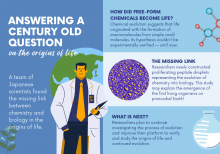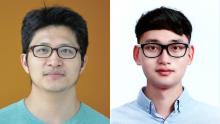Science
News
07 Oct 2021
Asia Research News features fascinating research from diverse voices. Our upcoming magazine will highlight your research with captivating articles written and visualized for a broad range of readers, produced by our professional team. Don't miss your chance to be a part of the 2022 edition.
05 Oct 2021
Researchers in Japan have found an energy-efficient way to convert the chief greenhouse gas carbon dioxide (CO2) into useful chemicals. Using the method, CO2 is transformed into structures called metal-organic frameworks (MOFs), suggesting a new and simpler route to dispose of the greenhouse gas to help tackle global warming.
05 Oct 2021
Researchers from DGIST explain how DNA is compacted to a million-times its full length in sperm cell nuclei
05 Oct 2021
Researchers at Kanazawa University describe in Chemical Society Reviews how large cyclic molecules can be used for the synthesis of big metallic complexes with two or more metal atoms.
01 Oct 2021
Tohoku University researchers, collaborating with colleagues from the Indian Institute of Technology Kanpur, have discovered the working mechanism of an important class of drug target receptor proteins.
01 Oct 2021
Novel design of brain chip implant allows for measuring neuronal activity while simultaneously delivering drugs to the implant site
01 Oct 2021
Researchers develop a composite film that can be used in nanogenerators to generate electricity from mechanical motion
01 Oct 2021
Paris, 29 September — UNESCO and the L'Oréal Foundation are unveiling the winners of this year’s International Prize for Women in Science, which honours five eminent women scientists with exceptional careers from the five regions of the world, as it has done annually since 1998.
29 Sep 2021
A research team led by scientists at Hong Kong Baptist University (HKBU) has developed a novel cell sensor with a barcode-like micro-channel structure that enables rapid and low-cost screening of drug-resistant bacteria. The invention could potentially be used on a large-scale in resource-limited situations such as frequent safety screenings of water, food and public facilities, as well as urgent surveys of massive samples during an infectious disease outbreak, particularly in developing countries.
28 Sep 2021
Researchers at Kanazawa University report in Science Advances a new method for distinguishing between enantiomers, molecules that are mirror images of each other. The procedure, relevant for the pharmaceutical industry, involves the chemical reaction of target enantiomers with color indicator compounds consisting of one-handed helical polymers, leading to solutions showing different colors in specific solvents between the enantiomers.
27 Sep 2021
Giants in History: Rajeshwari Chatterjee (24 January 1922 – 3 September 2010) was the first female engineer from Karnataka in India. Chatterjee earned a Master’s degree and doctoral degree from the University of Michigan on a scholarship awarded by the Delhi government

27 Sep 2021
Dell Technologies Malaysia (Dell) and Universiti Sains Malaysia (USM) have signed a two-year Memorandum of Understanding (MoU) in a milestone industry-academia move to produce more industry-ready graduates. The MoU provides a platform for Dell and USM to work hand-in-hand to groom and equip USM undergraduates to be highly employable graduates under the USM LIFE Programme, a new academic initiative that advocates creative and experiential learning.
27 Sep 2021
The missing link isn’t a not-yet-discovered fossil, after all. It’s a tiny, self-replicating globule called a coacervate droplet, developed by two researchers in Japan to represent the evolution of chemistry into biology.
24 Sep 2021
The Lingnan Entrepreneurship Initiative (LEI) of Lingnan University (LU) in Hong Kong has developed the CREW Wheelchair Control System which intelligently predicts a carer’s intentions so as to better control a wheelchair, improving the safety of both wheelchair users and carers. The research team recently won the Gold award at the international MUSE Design Awards, and has already filed patent applications in Hong Kong and Mainland for this ground-breaking system.
24 Sep 2021
An algorithm that detects events occurring across different time and geographical scales on social media could enable a more timely response to emerging events.
23 Sep 2021
Single cell analyses reveal hidden turgor-associated metabolic changes and water flow across the flesh in watercored apples

16 Sep 2021
Inspired by a kind of tree leaf, scientists at City University of Hong Kong (CityU) discovered that the spreading direction of different liquids deposited on the same surface can be steered, solving a challenge that has remained for over two centuries. This breakthrough could ignite a new wave of using 3D surface structures for intelligent liquid manipulation with profound implications for various scientific and industrial applications, such as fluidics design and heat transfer enhancement.
16 Sep 2021
A new approach leads to the long-awaited formation of rings made of three pyrroles, which could be used to produce compounds with a host of interesting properties, and explains why they have not been observed before.
15 Sep 2021
Using the lamprey, researchers from Japan analyzed the photosensory mechanism of the pineal organ, also called the pineal gland, in non-mammalian vertebrates and discovered a novel mechanism of pineal color discrimination (two-cell system) in which two types of photoreceptor cells, each containing two different opsins, are used to detect color. This discovery may provide insight into the evolution of color detection in other animals, including color vision in humans.
15 Sep 2021
New research published in Stem Cell Reports has found elevated cholesterol supply from astrocytes to neurons in the model of Alzheimer's disease (AD) brains, suggesting that modulating brain cholesterol could be explored in the search of treatment options for the devastating, degenerative disease.
14 Sep 2021
Researchers from The University of Tokyo assimilated satellite observations of water vapor isotopes into a weather forecasting model and found that forecast accuracy was improved by several percentage points
14 Sep 2021
When it comes to cancer, clarity is key. The ability to visualize cancerous tumors and metastatic tissue three dimensionally (3D) can help clinicians diagnose the precise type and stage of cancer, while also informing the best treatment methods. To obtain an even clearer tissue for imaging, a research team based in Japan has tested the effectiveness of specialized hydrogels. Acting as a 3D molecular network, these hydrogels can rapidly remove fats from tissues, which are a factor in tissue opacification, without losing their structure. The material is used in several biomedical devices, including contact lenses.
14 Sep 2021
The Lingnan Entrepreneurship Initiative (LEI) of Lingnan University has received two Gold awards at the MUSE Design Award in the category Conceptual Design for their “CREW Wheelchair Control System” and “12° Mask” respectively.
10 Sep 2021
Magnetic patterns in meteorites, Treating mitochondrial diseases, underwater sensors and a broad COVID-19 vaccine in the September Editor's Choice. Plus, what's it like to communicate vaccine research in a pandemic and Asia Research News 2022.
09 Sep 2021
Researchers succeed in the direct bonding of diamond and gallium nitride (GaN) at room temperature and demonstrate that the bond can withstand heat treatments of 1,000℃, making it ideal for the high temperature fabrication process of GaN-based devices. GaN-on-diamond semiconductor material will allow for the next generation of high power, high frequency devices.
07 Sep 2021
Recreating major pathological features of Parkinson’s disease in a lab-grown, human mini-brain will help researchers to explore new treatments. This is the first time that Lewy bodies, a hallmark of Parkinson’s disease in patients’ brains, have been produced in the laboratory, offering new insights into the disease.
06 Sep 2021
A synthetic CDK4/6 inhibitor exerts antitumor effects by forcing RB1 tumor-suppressor into an active status, but its single administration is not sufficiently effective. We find its combinatorial administration with an IKKβ inhibitor is significantly more effective in hepatocellular carcinoma treatment. Also, blockage of the IKK-NF-κB or AKT pathway enhances its effects on RB1-intact K-Ras mutated lung and colon cancers. CDK4/6 inhibitors have potential to treat various RB1-intact cancers when combined with an appropriate kinase inhibitor.
06 Sep 2021
Professor Toshifumi Satoh of Hokkaido University’s Graduate School of Engineering has taken up the challenge to create “Smart synthetic method.” Satoh and his colleagues proposed the idea of “Smart synthesis,” which aims to minimize the use of harmful chemicals and solvents for cleaner and more sustainable polymeric synthesis.
06 Sep 2021
Neuroscientists develop a new approach to better understand the neural mechanism underlying deductive and inductive reasoning
Events

10 Oct 2007
Seoul, S Korea - AsiaSim(Asia Simulation Conference) is an annual international conference to bring outstanding researchers together for presenting new expertise and experiences in the area of modeling and simulation, since 1999.

02 Nov 2007
Xiamen, China - This is a seminar in applied mathematics and scientific computing.

05 Nov 2007
KL, Malaysia - Among the objectives include sharing information on global status and development of functional foods/ functional ingredients with a special focus in the Asian region.

11 Dec 2007
Tsukuba Science City, Japan - IEEE APSCC 2007 serves as a major international forum for researchers and industry practitioners to exchange information regarding advancements in the state of art and practice of IT-driven business services.

09 Dec 2007
Doha, Qatar - The ASIAN conference series provides a forum for researchers throughout Asia to present cutting-edge results in yearly-themed areas of Computer Science, to discuss advances in these fields, and to interact with researchers from other continents. The 2007 edition focuses on computer and network security.

13 Oct 2007
Beijing, China - This event will address among others the scientific inquiry of human behavior, especially the claim of paranormal phenomena, alternative medicine and pseudoscience, the research on secular humanism and planetary ethics.

25 Sep 2007
Victoria, Australia - Australian industries such as mining, aviation, finance, security and public health will reap long-term benefits from this meeting of mathematical minds.

09 Oct 2007
London, UK - Engage with those from a wide range of sectors and from across the world who are leading the debate on the key challenges of our time.

28 Oct 2007
Jaipur, India - The gamut of subjects covered by the Conference is comprehensive and wide-scoped. It encompasses all aspects of lakes and wetlands.

28 Oct 2007
Perth, Australia - The conference focuses on the challenges of finding solutions through technical innovation, integrated management of the complete water cycle, training, education, capacity building and the necessary policy, regulatory and governance settings.

11 Nov 2007
Auckland, NZ - There will be four full days of oral and poster research presentations, covering the spectrum from geochemistry to microbiology, and all fields in between.

23 Sep 2007
Victoria, Australia - Chemeca 2007 conference will interest all professionals in the chemical engineering and chemical process related sectors.

18 Nov 2007
Perth, Australia - The conference will feature a three day exhibition and four days of technical presentations, plus an opening panel discussion on Peak Oil.

05 Oct 2007
Kyoto, Japan - This is an ideal place to engage in the mutual exchange of new scientific knowledge and enjoy fruitful, exciting, discussions spanning the various fields of autonomic neuroscience, from both basic and clinical aspects.

02 Oct 2007
Sydney, Australia - GREENHOUSE 2007 is a unique opportunity to hear the latest findings in climate science, and discuss the implications for Australia and the region.

25 Sep 2007
Brisbane, Australia - ‘Psychology Making an Impact' will provide a unique opportunity for local and international delegates to hear from leading psychologists in a program of interactive workshops, cutting-edge research papers, rapid communication posters and exciting symposia and fora.

16 Nov 2007
KL, Malaysia - Examples will be drawn from throughout the developing world, not just Southeast Asia.

05 Mar 2008
Revealing the secret of the glorious Islamic civilization in the West. The theme for this conference is Knowledge Integration Based On Tawhid.

18 Sep 2007
Skill Science is a new multidisciplinary research area with approaches including artificial intelligence, cognitive science, sports science, bio-mechanism, ecological psychology and so on. In the future, it is expected to bring insight into researches on robotics, aiming to bring human-like flexible and skillful movement into realization.

27 Nov 2007
The Asian Internet Engineering Conference (AINTEC) 2007 is scheduled to be held on 27-29 November 2007 at the Katathani Phuket Beach Resort Hotel in Phuket, Thailand and is co-organized by Internet Education and Research Laboratory (intERLab), AIT, Thailand and the WIDE Project, Japan. Theme: "Internet for Sustainable Communication"

03 Dec 2007
The Asian Association for Agricultural Engineering (AAAE) is organizing its International Agricultural Engineering Conference (IAEC) – 2007 to be held from December 3 - 6, 2007 at AIT.

26 Sep 2007
AIT’s EPSM/Energy Field of Study is organizing a training workshop on "Biofuel Technology and Management," from 26-28 September 2007, at the AIT Conference Center.

12 Dec 2007
The Greater Mekong Subregion Academic and Research Network (GMSARN) will organize the second GMSARN International Conference 2007 on "Sustainable Development: Issues and Prospects for the Greater Mekong Subregion", to be held on 12-14 December 2007 at the Ambassador City Jomtien Hotel, Pattaya, Thailand.

21 Nov 2007
The Southeast Asia Urban Environmental Management Applications (SEA-UEMA) Project, in cooperation with the Ho Chi Minh City University of Technology, will hold the International Conference on Air Quality Management in Southeast Asia on November 21 to 23, 2007.

22 Nov 2007
A gathering of students, educators, researchers and other interested parties to discuss the development of geographical research and education in the Philippines.

03 Sep 2007
The Quantum Group of the Quantum Bio-Informatics Center’s (QBIC) Research Center will host an event entitled the “Mini-Workshop on Recent Experimental Results of Cuprates.” Researchers from differing fields (STM, ARPES, Neutron, NMR, etc.) will be invited to the mini-workshop to explore its topic over the course of two days.

04 Oct 2007
Lima, Peru - The workshop will be a two-day, hands-on session designed to provide information on the current state of public perception of agricultural biotechnology in APEC member economies.

25 Oct 2007
Bangalore, India - This conference aims to bring together work on sources of entrepreneurship, the challenges in enabling and sustaining entrepreneurship and innovation, and issues in entrepreneurship culture.

12 Dec 2007
Bangkok - Reinventing Higher Education: Toward Participatory and Sustainable Development. This conference will provide a unique forum for participants to explore the role and involvement of universities and higher education institutions within the framework of participatory development.

31 Aug 2007
BERLIN, GERMANY - IFA reports appeared in trade journals around the world as well as in 100 German dailies and 80 foreign newspapers
Giants in history
Chinese biochemist Chi Che Wang (1894 - 1979), one of the first Chinese women to study abroad, advanced to prominent research positions at American institutions including the University of Chicago and the Northwestern University Medical School.
Ruby Sakae Hirose (1904 – 1960) was a Japanese-American scientist whose research contributed significantly to our understanding of blood clotting, allergies and cancer.
Chinese electron microscopy specialist Li Fanghua (6 January 1932 – 24 January 2020) facilitated the high-resolution imaging of crystal structures by eliminating interference.
Sálim Moizuddin Abdul Ali (12 November 1896 – 20 June 1987), commonly referred to as the Birdman of India, was the first person to conduct systematic surveys of birds from across India.
Haisako Koyama (1916 – 1997) was a Japanese solar observer whose dedication to recording sunspots – cooler parts of the sun’s surface that appear dark – produced a sunspot record of historic importance.
Michiaki Takahashi (17 February 1928 – 16 December 2013) was a Japanese virologist who developed the first chickenpox vaccine.
Toshiko Yuasa (11 December 1909 – 1 February 1980) was the first Japanese female physicist whose research on radioactivity shed light on beta decay – the process in which an atom emits a beta particle (electron) and turns into a different element.
Angelita Castro Kelly (1942-2015) was the first female Mission Operations Manager (MOM) of NASA. She spearheaded and supervised the Earth Observing System missions during its developmental stage.
Malaysia’s first astrophysicist, Mazlan binti Othman (born 11 December 1951) was instrumental in launching the country’s first microsatellite, and in sending Malaysia’s first astronaut, Sheikh Muszaphar Shukor, into space.
Known as Mr. Natural Rubber, chemist and researcher B. C. Shekhar (17 November 1929 – 6 September 2006) introduced a number of technical innovations that helped put Malaysia’s natural rubber industry on the world map.
Shinichiro Tomonaga (31 March 1906 – 8 July 1979), together with Richard Feynman and Julian Schwinger, was awarded the Nobel Prize in Physics in 1965, for their contributions to advance the field of quantum electrodynamics. Tomonaga was also a strong proponent of peace, who actively campaigned against the proliferation of nuclear weapons and promoted the peaceful use of nuclear energy.
South Korean theoretical physicist Daniel Chonghan Hong (3 March 1956 – 6 July 2002) achieved fame in the public sphere through his research into the physics of popcorn.
Japanese chemist Kenichi Fukui (4 October 1918 – 9 January 1998) was the first Asian scientist to be awarded the Nobel Prize in Chemistry. Together with Roald Hoffman, he received this honour in 1981 for his independent research into the mechanisms of chemical reactions.
Chinese palaeontologist, archaeologist and anthropologist Pei Wenzhong (January 19, 1904 – September 18, 1982) is regarded as a founder of Chinese anthropology.
Physicist Narinder Singh Kapany (31 October 1926 – 4 December 2020) pioneered the use of optical fibres to transmit images, and founded several optical technology companies. Born in Punjab, India, he worked at a local optical instruments factory before moving to London for PhD studies at Imperial College. There, he devised a flexible fibrescope to convey images along bundles of glass fibres.
Japanese physicist Ukichiro Nakaya (1900-1962) made the world’s first artificial snowflakes. He started his research on snow crystals in the early 1930s at Hokkaido University, where there is an unlimited supply of natural snow in winter. By taking over 3,000 photographs, he established a classification of natural snow crystals and described their relationship with weather conditions.
The field of solid-state ionics originated in Europe, but Takehiko Takahashi of Nagoya University in Japan was the first to coin the term ‘solid ionics’ in 1967. ‘Solid-state ionics’ first appeared in 1971 in another of his papers, and was likely a play on ‘solid-state electronics’, another rapidly growing field at the time.
Charles Kuen Kao (Nov. 4, 1933 to Sept. 23, 2018) was an engineer who is regarded as the father of fibre optics. His work in the 1960s on long distance signal transmission using very pure glass fibres revolutionized telecommunications, enabling innovations such as the Internet.
Chika Kuroda (24 March 1884 – 8 November 1968) was a Japanese chemist whose research focussed on the structures of natural pigments.
Motoo Kimura (13 November 1924 – 13 November 1994) was a Japanese theoretical population geneticist who is best remembered for developing the neutral theory of molecular evolution.
Meghnad Saha (6 October 1893 – 16 February 1956) was an Indian astrophysicist best known for formulating the Saha ionization equation which describes the chemical and physical properties of stars.
Sir Jagadish Chandra Bose (30 November 1858 – 23 November 1937) was a scientist and inventor who contributed to a wide range of scientific fields such as physics, botany and biology.
Osamu Shimomura (27 August 1928 – 19 October 2018) was a Japanese organic chemist and marine biologist who dedicated his career to understanding how organisms emitted light.
Subrahmanyan Chandrasekhar (19 October 1910 – 21 August 1995) was an Indian astrophysicist who studied the structure and evolution of stars.
Joo-myung Seok (November 13, 1908 – October 6, 1950) was a Korean butterfly entomologist who made important contributions to the taxonomy of the native butterfly species in Korea.
Mathematician Maryam Mirzakhani (12 May 1977 – 14 July 2017) was the first and only woman and Iranian to date to win the Fields Medal in 2014 for her work on curved surfaces.
Sir Chandrasekhara Venkata Raman (7 November 1888 – 21 November 1970) was an Indian physicist who performed ground-breaking research in the field of light-scattering.
Mohammad Abdus Salam (29 January 1926 – 21 November 1996) was a theoretical physicist and the first Pakistani to receive a Nobel Prize in science.
Srinivasa Ramanujan (22 December 1887 – 26 April 1920) was a math prodigy and widely considered one of India’s greatest mathematicians. Despite having almost no formal training in mathematics, he made substantial contributions to mathematical analysis, number theory, infinite series and continued fractions.
Gopalasamudram Narayanan Ramachandran (8 October 1922 – 7 April 2001) is best known for developing the Ramachandran plot to understand the structure of short chains of amino acids, known as peptides.
Hitoshi Kihara (1893 – 1986) was one of the most famous Japanese geneticists of the 20th century. One of his most significant contributions was identifying sex chromosomes (X and Y) in flowering plants.
Chien-Shiung Wu (31 May 1912 – 16 February 1997) was an experimental physicist who made several important contributions to nuclear physics. Wu worked on the Manhattan Project – a top-secret program for the production of nuclear weapons during World War II and helped to develop a process for separating uranium into U235 and U238.
Meemann Chang (born 17 April 1936) is a Chinese palaeontologist who studied the fossils of ancient fish to understand the evolution of life. By examining fossils, she uncovered new insights on how vertebrates, animals with a backbone, migrated from the sea and became adapted to live on land.
Bibha Chowdhuri (1913 – 2 June 1991) was an Indian physicist who researched on particle physics and cosmic rays. In 1936, she was the only female to complete a M.Sc. degree at the University of Calcutta.
Lin Lanying (7 February 1918 – 4 March 2003) was a Chinese material engineer remembered for her contributions to the field of semiconductor and aerospace materials. Lanying was born into a family who did not believe in educating girls and she was not allowed to go to school.
Japanese geochemist Katsuko Saruhashi developed the first method and tools for measuring carbon dioxide in seawater

















![The chemical structure and solids crystals of calix[3]pyrrole (Photo: Inokuma Laboratory).](https://www.asiaresearchnews.com/sites/default/files/styles/medium/public/articles_images/P2136%20Fig1%20crystal%20photo.jpg?itok=NMWDp6vl)













































